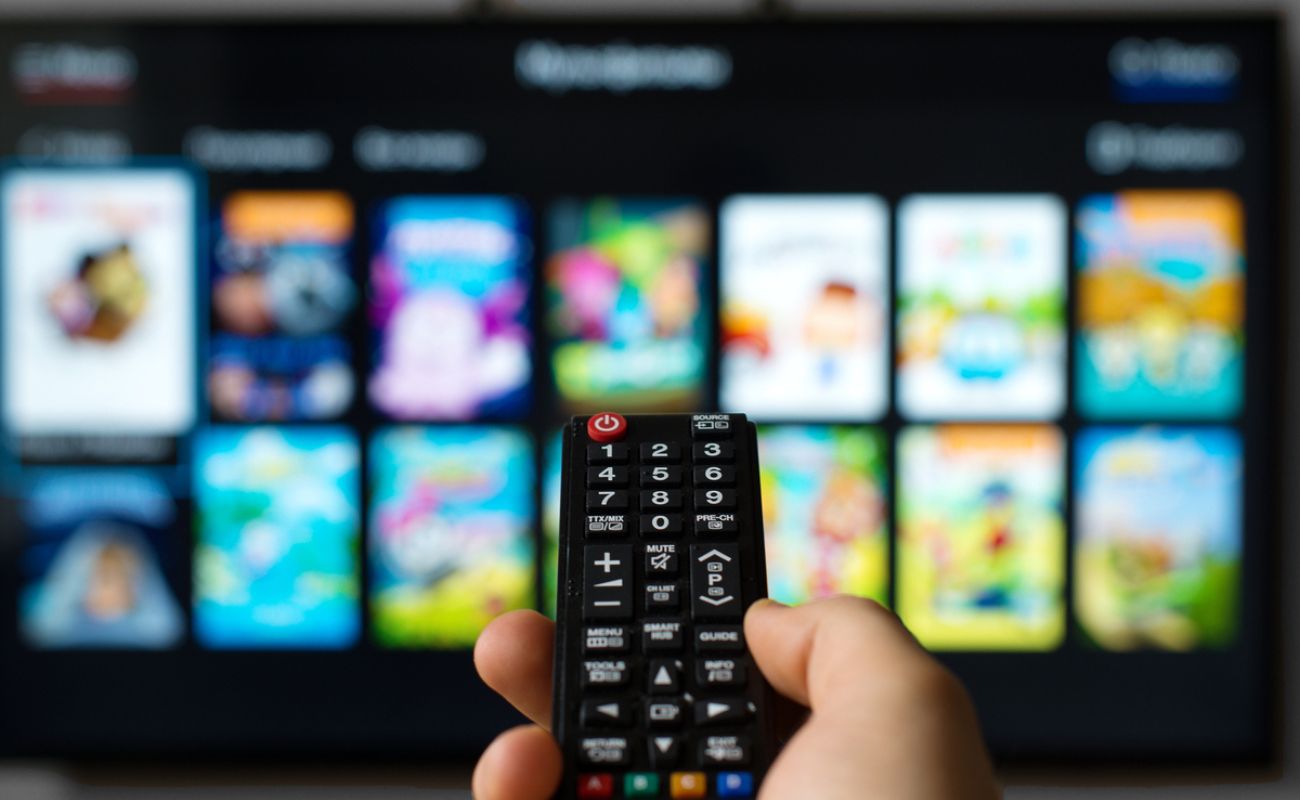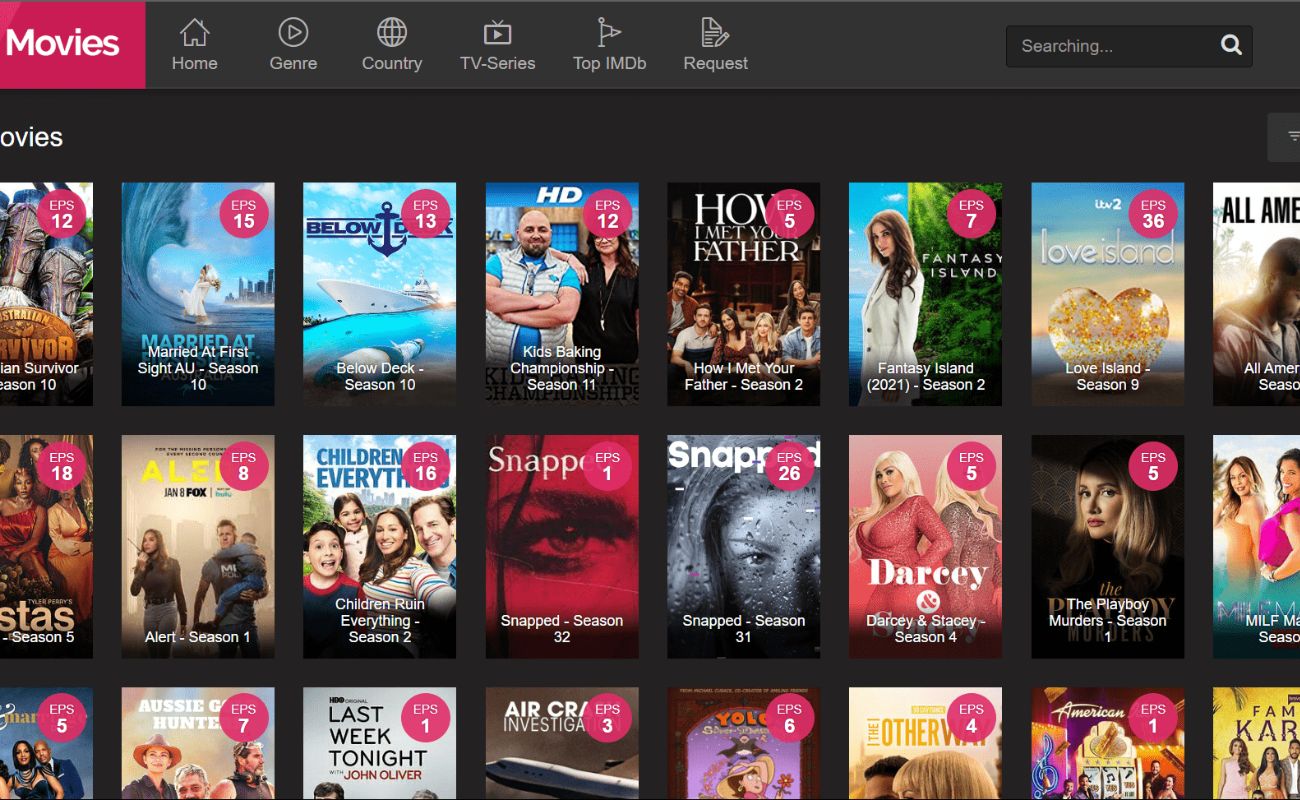Home>Technology>Home Entertainment Systems>Why Would Anyone Pay Someone To Know What They Are Watching On Television


Home Entertainment Systems
Why Would Anyone Pay Someone To Know What They Are Watching On Television
Modified: January 9, 2024
Discover the value of home entertainment systems and why people are willing to pay for a service that tracks their TV viewing habits.
(Many of the links in this article redirect to a specific reviewed product. Your purchase of these products through affiliate links helps to generate commission for Storables.com, at no extra cost. Learn more)
Introduction
Welcome to the digital age, where everything is interconnected, accessible, and trackable. From smartphones to smart TVs, technology has revolutionized the way we consume entertainment. As such, the need for accurate audience measurement and ratings has become paramount in determining the success and profitability of television shows and movies.
But why would anyone pay to know what people are watching on their TVs? The answer lies in the value of audience measurement – the process of gathering data on viewership and audience demographics. This information is vital for networks, advertisers, and content creators to make informed decisions about programming and marketing strategies.
Traditionally, ratings have been the primary yardstick for measuring audience engagement. These ratings are based on statistical samples of viewership data from a limited number of households. While they provide valuable insights, they have their limitations. The rise of digital media and streaming platforms has further complicated matters, challenging the effectiveness of traditional ratings systems.
Fortunately, advancements in technology and data analytics have opened up new possibilities for audience measurement. Today, we have access to vast amounts of data that can be analyzed to generate valuable insights into viewer preferences, habits, and trends. This data-driven approach allows for more accurate and precise targeting, enabling advertisers and content creators to tailor their offerings to specific audience segments.
However, the evolution of audience measurement methods has not been without challenges. Privacy concerns and ethical considerations have cast a spotlight on the gathering and utilization of personal data. Striking the right balance between data collection and privacy protection is of utmost importance to ensure the trust of viewers and maintain the integrity of the measurement process.
In this article, we will explore the value of audience measurement, examine the role of ratings, discuss the limitations of traditional ratings systems, delve into the rise of digital media, highlight the importance of data analytics, and discuss the evolution and promise of advanced targeting methods. We will also address the challenges and concerns associated with audience measurement in the digital age. So, let’s dive in and uncover the fascinating world of audience measurement and its impact on the world of home entertainment systems.
Key Takeaways:
- Audience measurement is crucial for understanding viewer behaviors and preferences in the digital age of home entertainment systems. Data analytics and advanced targeting offer the promise of personalized experiences while respecting viewer privacy and diversity.
- The evolution of audience measurement methods brings challenges and concerns, including data accuracy, algorithmic bias, and content diversity. Responsible and ethical practices are essential for navigating these challenges and unlocking the full potential of audience measurement.
Read more: Why Would Someone Steal A Ring Doorbell
The Value of Audience Measurement
Audience measurement plays a crucial role in the world of home entertainment systems. It provides valuable insights into viewership patterns, preferences, and demographics, helping networks, advertisers, and content creators make informed decisions. Let’s explore the key reasons why audience measurement holds such great value.
First and foremost, audience measurement allows networks and content creators to understand which shows and movies are resonating with viewers. By tracking viewership data, they can gauge the popularity and success of their content. This information helps them identify trends and make informed decisions about programming and scheduling. For content creators, this can be an invaluable tool in shaping their future projects and tailoring their offerings to meet audience demands.
For advertisers, audience measurement is essential in determining how to allocate their marketing budgets effectively. By obtaining data on viewership demographics, preferences, and habits, advertisers can identify the most lucrative advertising slots and target specific audience segments. This not only maximizes the impact of their campaigns but also ensures that their ads reach the right people at the right time.
Moreover, audience measurement provides insights into viewer engagement and retention. By analyzing data such as average viewing time, audience drop-off rates, and audience loyalty metrics, networks can assess the effectiveness of their content and engagement strategies. This data enables them to make adjustments and improvements to their programming, leading to increased viewer satisfaction and loyalty.
Additionally, audience measurement plays a crucial role in the licensing and distribution of content. Production companies rely on audience data to negotiate deals with networks, streaming platforms, and international distributors. The ability to demonstrate a show’s potential audience size and appeal can greatly impact its distribution reach and profitability.
Furthermore, audience measurement facilitates market research. By gathering data on audience preferences and behaviors, networks and content creators can gain a deeper understanding of the ever-evolving tastes and expectations of viewers. This knowledge can inform content development strategies and aid in the creation of shows and movies that cater to specific audience segments.
Overall, audience measurement provides a comprehensive and data-driven view of the television and movie landscape. It guides decision-making, informs marketing strategies, and helps shape the future of home entertainment systems. Without accurate audience measurement, networks, advertisers, and content creators would be operating blindly, facing greater uncertainties and risks in an already competitive industry.
The Role of Ratings
Ratings have long been the standard metric for measuring the popularity and success of television shows and movies. They provide a snapshot of viewership data, allowing networks, advertisers, and content creators to assess the performance of their content. Let’s dive deeper into the role that ratings play in the world of home entertainment systems.
At its core, ratings are a numerical representation of viewership. They indicate the number of households or individuals who watched a particular show or movie during a specific time period. Ratings are typically expressed as a percentage, representing the share of the total audience that tuned in.
Ratings serve multiple purposes in the industry. For networks, they act as a performance indicator, allowing them to compare the success of different shows and make decisions regarding renewals, cancellations, and programming changes. Advertisers rely on ratings to gauge the potential reach and impact of their marketing campaigns, making informed decisions about where to allocate their advertising budgets.
Furthermore, ratings provide a benchmark for content creators to measure their success and impact. They serve as a validation of their creative efforts and help shape their reputation within the industry. High ratings can attract accolades and recognition, opening doors for future opportunities.
While ratings have played a crucial role in the past, their limitations are becoming increasingly apparent in today’s digital landscape. Ratings are based on statistical samples, which means they represent a subset of the total audience. This sample may not accurately reflect the diversity of viewership across different demographics and platforms.
The rise of streaming platforms has further complicated matters. Many streaming services do not publicly release viewership data, making it challenging to assess the success of shows and movies that are exclusively available on these platforms. This lack of transparency has prompted discussions about the need for new metrics and measurement methods that can capture the full extent of viewership in the digital age.
Despite their limitations, ratings remain a fundamental tool in the industry, providing valuable insights into viewership patterns and trends. They continue to serve as a common language that networks, advertisers, and content creators can rely on for decision-making purposes.
However, it is important to recognize that ratings are just one piece of the puzzle. In an increasingly fragmented media landscape, relying solely on ratings can lead to missed opportunities and inaccurate assessments of content performance. The industry is continually exploring new ways to measure audience engagement and reach beyond traditional ratings systems.
In the next sections, we will delve into the challenges and limitations of traditional ratings systems, as well as explore the advancements in audience measurement methods that are paving the way for a more data-driven and comprehensive approach to understanding audience behavior in the home entertainment systems realm.
Limitations of Traditional Ratings Systems
While traditional ratings systems have been the industry standard for measuring audience viewership, they have their fair share of limitations. These limitations have become even more apparent in the digital age, where viewers have more options and access to content than ever before. Let’s explore some of the key limitations of traditional ratings systems.
First and foremost, traditional ratings systems rely on statistical samples to estimate viewership. The data collected is based on a representative subset of households or individuals who have agreed to be part of the ratings panel. This sample size is often small compared to the total population, leading to the possibility of skewed or inaccurate results. The sample may not accurately represent the diversity of viewership across different demographics, geographical regions, or platforms.
Another limitation of traditional ratings systems is their inability to capture viewership across multiple platforms. In today’s digital landscape, viewers have the flexibility to watch their favorite shows and movies on various devices and streaming platforms. Traditional ratings systems primarily focus on live television viewership and may not account for delayed viewing, on-demand streaming, or viewing on mobile devices. This means that traditional ratings may not accurately reflect the true audience size and engagement levels.
The lack of granularity is another significant limitation of traditional ratings systems. Ratings typically provide high-level viewership data, such as the total number of households or individuals watching a program. However, they do not provide insights into viewer behaviors, preferences, or demographics beyond age and gender. This lack of detailed information can make it challenging for advertisers and content creators to target specific audience segments effectively.
Furthermore, traditional ratings systems often do not account for engagement beyond the initial viewership. Viewership duration, audience retention, and repeat viewership are crucial factors in understanding the success and appeal of a show or movie. Traditional ratings systems may not capture these nuances, which can lead to a skewed perception of audience interest and engagement.
Moreover, traditional ratings systems have faced criticism for their slow reporting time. The process of collecting, analyzing, and reporting ratings data can take days or even weeks, which can hinder real-time decision-making for networks, advertisers, and content creators. In a fast-paced industry where timely insights are crucial, this lag in reporting can be a significant drawback.
Lastly, privacy concerns have emerged with traditional ratings systems. Participants in the ratings panel may feel uneasy about their viewing habits being tracked and recorded. As data privacy regulations become stricter, traditional ratings systems may need to adapt to ensure compliance and maintain the trust of viewers.
These limitations have prompted the need for more sophisticated and comprehensive audience measurement methods that adapt to the evolving media landscape. In the next sections, we will explore the rise of digital media and the advancements in data analytics that are reshaping the field of audience measurement, addressing these limitations and providing a more accurate and nuanced understanding of audience behaviors in the home entertainment systems realm.
The Rise of Digital Media
The advent of digital media has revolutionized the home entertainment systems landscape, providing viewers with unprecedented access to a plethora of content and platforms. Digital media refers to the distribution of audio, video, and other media content through digital channels, such as streaming services, video-on-demand platforms, and online content providers. This shift in consumption habits has had a profound impact on audience measurement and ratings. Let’s explore the rise of digital media and its implications.
One of the key drivers behind the rise of digital media is the convenience and flexibility it offers. With streaming services like Netflix, Hulu, and Amazon Prime Video, viewers can binge-watch entire seasons of their favorite shows, pause and resume at their convenience, and discover new content recommendations tailored to their interests. This shift towards on-demand and personalized viewing experiences has challenged the traditional model of scheduled programming and live television.
In addition to streaming platforms, video-sharing websites and social media have also contributed to the rise of digital media. Platforms like YouTube and TikTok allow users to consume and share video content on a global scale. This democratization of content creation and distribution has given rise to a new generation of influencers and online celebrities, who attract large audiences and shape trends in the digital space.
Furthermore, the ubiquity of mobile devices and high-speed internet connectivity has made digital media more accessible than ever before. Viewers can now watch their favorite TV shows and movies on smartphones, tablets, and smart TVs anytime, anywhere. This increased accessibility and portability have fueled the demand for digital content, further bolstering its popularity.
The rise of digital media has presented both opportunities and challenges for audience measurement. On the one hand, digital platforms provide a wealth of data that can be analyzed to gain insights into viewership and consumption patterns. Streaming services and online platforms have access to detailed viewership data, such as play counts, view duration, and audience engagement metrics. This data can help content creators, networks, and advertisers make data-driven decisions and understand their audience better.
However, the fragmented and decentralized nature of digital media has introduced new complexities to audience measurement. With viewership spread across various platforms, it becomes challenging to capture an accurate and comprehensive view of audience behavior. Traditional ratings systems, which primarily focus on live television viewership, may not fully capture the viewership numbers and engagement levels in the digital realm.
Moreover, the lack of transparency in viewership data from streaming services has raised questions about the comparability and reliability of measurements. While platforms like Netflix and Amazon Prime Video have started sharing some viewership data for select shows and movies, they generally do not release comprehensive data for all their content. This limited transparency has led to calls for more standardized and transparent metrics in the digital space.
Despite these challenges, the rise of digital media has brought about a new era of audience measurement possibilities. Advanced data analytics, machine learning algorithms, and artificial intelligence are being leveraged to analyze vast amounts of viewership data. These technologies enable more granular and real-time measurement of audience behaviors and preferences, paving the way for a more accurate understanding of viewership in the digital age.
In the next section, we will delve into the importance of data analytics in audience measurement and how it is reshaping the field.
Consider the value of time and convenience. Some people may be willing to pay for a service that helps them quickly find and access the content they want to watch, saving them time and effort in the process.
Read more: What Is The Most Watched Television Event
The Importance of Data Analytics
Data analytics plays a critical role in audience measurement, providing the tools and techniques necessary to make sense of the vast amounts of viewership data available in the digital age. By analyzing this data, networks, advertisers, and content creators can gain valuable insights into viewer behaviors, preferences, and trends. Let’s explore the importance of data analytics in audience measurement and its impact on the world of home entertainment systems.
First and foremost, data analytics allows for a more granular understanding of audience behaviors. By analyzing viewership data, such as play counts, view duration, and device preferences, networks can gain insights into which shows and movies are resonating with viewers. This information helps them identify patterns and make data-driven decisions about programming, scheduling, and content development. Advertisers can also leverage data analytics to understand audience segments and target their campaigns effectively, increasing the likelihood of reaching their desired audience.
Furthermore, data analytics enables real-time monitoring and measurement of audience engagement. With the availability of streaming services and on-demand content, viewers now have the freedom to watch shows and movies at their own pace. Data analytics tools can track and analyze viewership patterns, including binge-watching behaviors, pause and resume rates, and audience drop-off points. This information provides valuable insights into viewer engagement, allowing networks and content creators to identify areas for improvement and optimize their offerings accordingly.
Data analytics also empowers content personalization and recommendation systems. By analyzing viewership data and understanding individual preferences, streaming platforms and online content providers can deliver personalized recommendations to viewers. These recommendations are based on sophisticated algorithms that consider factors such as viewing history, genre preferences, and user ratings. This personalized approach enhances the viewer experience, increases engagement, and drives user retention.
Moreover, data analytics helps to unlock the power of data for targeted advertising. By analyzing viewership demographics, interests, and behavioral patterns, advertisers can tailor their campaigns to specific audience segments. This targeted approach minimizes wasted ad spend and increases the likelihood of reaching viewers who are genuinely interested in the product or service being advertised. Data analytics also allows for real-time campaign optimization, enabling advertisers to adjust and refine their strategies based on performance metrics.
However, it is important to strike a balance between utilizing viewer data for audience measurement purposes and respecting viewer privacy. Stricter data privacy regulations and ethical considerations underline the importance of responsible data handling and ensuring the anonymity and security of viewer information. Transparency and consent are key in obtaining and utilizing viewer data for audience measurement and targeted advertising.
In summary, data analytics plays a vital role in audience measurement by extracting meaningful insights from the vast amounts of viewership data available in the digital landscape. It enables networks, advertisers, and content creators to better understand audience behaviors, personalize the viewing experience, optimize content offerings, and drive targeted advertising campaigns. As technology continues to evolve, data analytics will continue to be crucial in navigating the ever-changing landscape of home entertainment systems.
The Evolution of Audience Measurement Methods
As the home entertainment systems landscape has evolved, so too have the methods used for audience measurement. Traditional ratings systems, based on statistical samples and limited to live television viewership, are no longer sufficient in capturing the full extent of audience behavior in the digital age. Let’s explore the evolution of audience measurement methods and the advancements that have shaped the field.
The rise of digital media and the availability of vast amounts of viewership data have paved the way for more sophisticated and data-driven audience measurement methods. One notable advancement is the utilization of set-top boxes and smart TVs, which enable the collection of detailed viewership data at the household level. These devices track viewership habits, allowing for the measurement of not just the number of households watching a program, but also the duration of viewing, channel switching patterns, and engagement metrics.
In addition to set-top boxes and smart TVs, the widespread use of streaming platforms has further expanded the possibilities for audience measurement. Streaming services have access to a wealth of data on viewership, including play counts, view duration, and user interactions. This data can be leveraged to gain insights into viewing habits, binge-watching behaviors, and content preferences. Streaming platforms can also analyze this data to personalize recommendations and optimize their content libraries.
Machine learning and artificial intelligence algorithms have also played a significant role in the evolution of audience measurement. These advanced technologies can analyze vast amounts of viewership data, identifying patterns and correlations that may not be immediately apparent. By utilizing these algorithms, networks and content creators can gain deeper insights into audience behaviors, preferences, and engagement levels.
Another notable evolution in audience measurement methods is the integration of online surveys and panels. These surveys allow viewers to provide feedback and opinions on specific shows or movies, helping to capture qualitative data on audience satisfaction and perception. Panels composed of representative viewers can also provide valuable insights into viewership demographics and behaviors.
Additionally, social media analytics have become increasingly relevant in audience measurement. Social media platforms provide a unique window into audience conversations and sentiments surrounding specific programs. By monitoring social media discussions, networks and advertisers can gain real-time insights into audience reactions, trends, and viral moments related to TV shows and movies. This information can be used to inform content development, marketing strategies, and engagement campaigns.
Moreover, data integration and data fusion techniques have become essential in the evolution of audience measurement. The ability to combine data from multiple sources, such as set-top boxes, streaming platforms, and social media, allows for a more holistic view of audience behaviors and preferences. Data fusion techniques help reconcile and analyze data from different sources, providing a comprehensive understanding of viewership habits across platforms.
It is worth noting that the evolution of audience measurement methods also brings about challenges. Data privacy concerns and ethical considerations require responsible and transparent data handling practices. Establishing standards and regulations for data governance and privacy is essential to maintain the trust of viewers and ensure the integrity of audience measurement.
Overall, the evolution of audience measurement methods has been driven by advancements in technology, the rise of digital media platforms, and the availability of vast amounts of viewership data. These advancements have allowed for more detailed, nuanced, and data-driven insights into audience behaviors and preferences. As technology continues to advance and viewing habits evolve, audience measurement methods will continue to adapt, providing a more accurate and comprehensive understanding of viewer engagement in the home entertainment systems realm.
The Promise of Advanced Targeting
Advanced targeting is an exciting development in the world of audience measurement. This approach leverages the wealth of data available to target specific audience segments with tailored content and advertisements. By analyzing viewership data, demographics, and online behavior, advanced targeting offers the promise of delivering personalized and relevant experiences to viewers. Let’s explore the potential benefits and implications of advanced targeting in the realm of home entertainment systems.
One of the key promises of advanced targeting is the ability to deliver highly personalized content recommendations. By analyzing viewers’ past viewing habits, preferences, and ratings, streaming platforms and content providers can present tailored suggestions that align with individual tastes. This personalization enhances the viewer experience, increases engagement, and fosters long-term loyalty.
Moreover, advanced targeting holds great potential for advertisers, offering a more effective way to reach their target audience. By leveraging data analytics and profiling techniques, advertisers can identify the audience segments that are most likely to be interested in their products or services. This enables targeted advertising campaigns that maximize the impact of each ad impression and increase the likelihood of conversions.
Instead of relying solely on demographic information, advanced targeting takes into account viewers’ interests, behaviors, and preferences, providing a more accurate understanding of their motivations and decision-making processes. This allows advertisers to craft messages that resonate with specific audience segments. For example, an advertiser can target horror enthusiasts with ads for upcoming horror movies, or food lovers with ads for a new cooking show.
Additionally, advanced targeting can help content creators and networks make data-driven decisions about content development and programming. By analyzing viewership data and engagement metrics, they can gain insights into which genres, storylines, or actors resonate with specific audience segments. This information can inform the creation of new shows, the renewal or cancellation of existing ones, and the optimization of programming schedules.
However, it is important to strike a balance with advanced targeting and avoid excessive personalization or invasive advertising practices. Respecting viewer privacy and ensuring transparency and consent in data collection and usage are critical. Striking the right balance between personalization and privacy is essential to maintain viewer trust and foster a positive viewing experience.
Moreover, advanced targeting is not without its challenges. As viewers become accustomed to personalized experiences, they may also develop higher expectations. Content recommendations and targeted ads need to be relevant, valuable, and non-disruptive to maintain viewer engagement. Overreliance on data algorithms without considering serendipity and diverse content offerings may lead to a “filter bubble” effect, where viewers are only exposed to content within their comfort zones, limiting their exposure to new and diverse perspectives.
In summary, advanced targeting holds great promise in the realm of audience measurement. By leveraging data analytics and profiling techniques, personalized and tailored content recommendations and advertisements can be delivered to viewers. This benefits both viewers, who enjoy a more engaging and customized viewing experience, and advertisers, who can reach their target audience more effectively. However, responsible data handling, privacy considerations, and content diversity are vital to ensure the success and ethical implementation of advanced targeting in the home entertainment systems arena.
Challenges and Concerns
While audience measurement has evolved and advanced over the years, it is not without its challenges and concerns. As technology and data analytics continue to shape the field, several important issues need to be addressed to ensure the integrity, privacy, and ethical use of viewership data. Let’s explore some of the key challenges and concerns associated with audience measurement in the realm of home entertainment systems.
One of the primary concerns is the balance between data collection and viewer privacy. As audience measurement becomes more sophisticated, data is collected and analyzed at increasingly granular levels. This raises concerns about the protection of viewers’ personal information and the potential for data misuse. It is essential for organizations involved in audience measurement to prioritize data security, anonymization, and transparency to maintain viewer trust and comply with privacy regulations.
Moreover, the issue of consent and informed choice is critical. Viewers should be aware of how their data is being collected, used, and shared for audience measurement purposes. Transparency about data collection methods, the purpose of data usage, and options for opting out should be communicated clearly to viewers. Providing viewers with control over their data and respecting their preferences is crucial in maintaining an ethical approach to audience measurement.
Another challenge is the accuracy and representativeness of the data collected. Traditional ratings systems rely on statistical samples, which may not accurately reflect the diverse range of viewership behaviors and preferences. The rise of digital media and the fragmentation of viewing habits across various platforms further complicate the creation of comprehensive and representative samples. Efforts to improve data quality, expand sample sizes, and diversify panel recruitment will be crucial to ensure accurate and reliable audience measurement.
Furthermore, the fast-paced nature of the digital era poses challenges for real-time measurement and reporting. Traditional ratings systems may not be agile enough to capture viewership patterns, engagement levels, and emerging trends in a timely manner. To keep up with the rapidly evolving landscape, audience measurement methods need to adapt and provide more real-time insights. Additionally, networks and content creators need access to timely and accurate data to inform their decision-making processes effectively.
Another concern is the potential bias and algorithmic fairness in audience measurement. Machine learning algorithms and data analytics techniques are powerful tools, but they are not immune to biases. Biases can arise from the data collected, algorithm design, and human interpretation of the results. It is crucial to ensure that audience measurement methods are fair and unbiased, providing equitable representation and accurate insights into diverse demographics and viewer behaviors.
Finally, the constant pursuit of personalized recommendations and targeted ads brings forth concerns regarding content diversity and serendipity. While advanced targeting can enhance the viewer experience by delivering content that aligns with their interests, it is important to strike a balance and avoid creating filter bubbles. Ensuring exposure to a wide range of content and diverse perspectives is vital to encourage discovery, open-mindedness, and the exploration of new genres and ideas.
In summary, audience measurement in the home entertainment systems realm faces several challenges and concerns. Maintaining viewer privacy, ensuring data accuracy and representativeness, delivering real-time insights, addressing algorithmic bias, and fostering content diversity are crucial considerations. By addressing these challenges and concerns, the field of audience measurement can continue to evolve responsibly, providing valuable insights while respecting viewer rights and maintaining ethical practices.
Conclusion
Audience measurement in the world of home entertainment systems has come a long way, evolving alongside advancements in technology, the rise of digital media, and the availability of vast amounts of viewership data. The value of audience measurement cannot be overstated, as it provides crucial insights into viewer behaviors, preferences, and trends.
Traditional ratings systems have been the industry standard for many years, providing a snapshot of viewership data and assisting networks, advertisers, and content creators in making informed decisions. However, with the advent of digital media and streaming platforms, the limitations of traditional ratings systems have become apparent. The rise of set-top boxes, smart TVs, and streaming services has opened up new possibilities for more granular and holistic viewer measurement.
Data analytics has emerged as a powerful tool in audience measurement, allowing networks, advertisers, and content creators to gain deeper insights into audience behaviors and preferences. By analyzing vast amounts of viewership data, personalizing recommendations, and targeting advertisements, more tailored and relevant experiences can be provided to viewers.
However, the journey towards advanced audience measurement is not without its challenges and concerns. Striking the right balance between data collection and viewer privacy, ensuring data accuracy and representativeness, addressing algorithmic biases, and fostering content diversity are critical considerations. Respecting viewer rights and maintaining ethical practices are at the forefront of responsible audience measurement.
As technology continues to advance and viewing habits evolve, the field of audience measurement will continue to adapt and improve. The promise of advanced targeting, personalized recommendations, and real-time insights holds great potential for networks, advertisers, and content creators. By leveraging data analytics, embracing transparency and privacy protections, and embracing diversity, audience measurement in the home entertainment systems realm can continue to provide valuable insights and enhance the viewer experience.
In conclusion, audience measurement plays a crucial role in understanding and engaging with audiences in the ever-evolving landscape of home entertainment systems. With the advancements in technology and data analytics, we have the tools to capture, analyze, and utilize viewership data in ways that were never before possible. By navigating the challenges and concerns in an ethical and responsible manner, we can unlock the full potential of audience measurement, shaping the future of television and movies for the benefit of viewers, networks, advertisers, and content creators alike.
Frequently Asked Questions about Why Would Anyone Pay Someone To Know What They Are Watching On Television
Was this page helpful?
At Storables.com, we guarantee accurate and reliable information. Our content, validated by Expert Board Contributors, is crafted following stringent Editorial Policies. We're committed to providing you with well-researched, expert-backed insights for all your informational needs.














0 thoughts on “Why Would Anyone Pay Someone To Know What They Are Watching On Television”